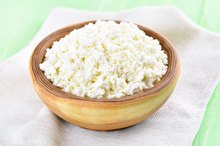Skin Rash From Dairy and Gluten
If you're suffering from an itchy skin rash, you may think it results from something you touched. However, you may want to consider dietary factors instead of a contact allergy. It's possible to manifest food allergy or intolerance symptoms in the form of skin rashes. Two top dietary culprits include dairy products and gluten, a form of grain protein found in wheat, barley and rye. It is likely you consume both dairy and gluten daily so one of them may be causing your persistent skin rash.
Basics
True food allergies can become life-threatening; if you're seriously allergic to nuts, for example, one whiff of a pecan can close up your throat, necessitating emergency medical treatment. However, most skin-based reactions to gluten and dairy do not involve medical emergencies. In fact, skin rash reactions to gluten, in particular, can take more than 24 hours to develop and several days to subside.
Dairy
A Skin Rash From Shell Fish
Learn More
Dairy represents one of the top eight allergens in the United States, according to the National Institutes of Health, and a dairy allergy can run the gamut from gastrointestinal symptoms to skin rashes. When you experience a skin-based reaction to dairy products, you are most likely reacting to the protein found in cow's milk called casein. Your reaction can occur immediately or it might take several hours or more to manifest. To permanently eliminate your rash, you will need to avoid milk and all cow's milk-based food items, including yogurt, cheese, cottage cheese, ice cream and many other products. Some people with a dairy-based skin rash are more sensitive to dairy products than others, so you may find you can keep your rash at bay simply eliminating major sources of casein.
- Dairy represents one of the top eight allergens in the United States, according to the National Institutes of Health, and a dairy allergy can run the gamut from gastrointestinal symptoms to skin rashes.
- Some people with a dairy-based skin rash are more sensitive to dairy products than others, so you may find you can keep your rash at bay simply eliminating major sources of casein.
Gluten
The rash gluten caused, known as dermatitis herpetiformis, occurs with celiac disease, which is gluten-induced inflammation of your small intestine. Dermatitis herpetiformis, an incredibly itchy rash, is not technically an allergic reaction and is not life-threatening. The rash usually doesn't appear instantly; in fact, some sufferers find it takes several days from the time they've consumed gluten to appear. To keep yourself clear of dermatitis herpetiformis lesions, you need to avoid all gluten — even microscopic amounts.
- The rash gluten caused, known as dermatitis herpetiformis, occurs with celiac disease, which is gluten-induced inflammation of your small intestine.
Considerations
Cheese Allergy & Rash
Learn More
Although gluten and milk proteins usually do not cause reactions that require emergency medical treatment, you should stay vigilant if you have a history of severe allergic reactions. You may also want to consider carrying an Epi-pen, a prescription syringe designed for self-injection that's filled with the quick-acting allergy medication, epinephrine, in case of emergency. People with allergies that cause rashes can sometimes experience severe reactions involving their airways. If you begin to develop itchy hives, mouth and throat swelling, and have trouble breathing, call 911 for immediate medical help.
- Although gluten and milk proteins usually do not cause reactions that require emergency medical treatment, you should stay vigilant if you have a history of severe allergic reactions.
Related Articles
References
- University of Maryland Medical Center; Food Allergy; March 17, 2010
- Amherst College: Milk and Dairy Allergies
- National Institutes of Health: Preventing and Treating Food Allergy
- Ludvigsson JF, Leffler DA, Bai JC, et al. The Oslo definitions for coeliac disease and related terms. Gut. 2013;62(1):43-52. doi:10.1136/gutjnl-2011-301346
- Gujral N, Freeman HJ, Thomson AB. Celiac disease: prevalence, diagnosis, pathogenesis and treatment. World J Gastroenterol. 2012;18(42):6036-59. doi:10.3748/wjg.v18.i42.6036
- Cianferoni A. Wheat allergy: diagnosis and management. J Asthma Allergy. 2016;9:13-25. doi:10.2147/JAA.S81550
- Ludvigsson J. et al. The Oslo definitions for coeliac disease and related terms. Gut. 2013 Jan;62(1):43-52. doi: 10.1136/gutjnl-2011-301346. Epub 2012 Feb 16.
Writer Bio
J.M. Andrews has been a professional journalist for more than 20 years. She specializes in health and medical content for consumers and health professionals. Andrews' background in medicine and science has earned her credits in a wide range of online and print publications, including "Young Physicians" magazine.









